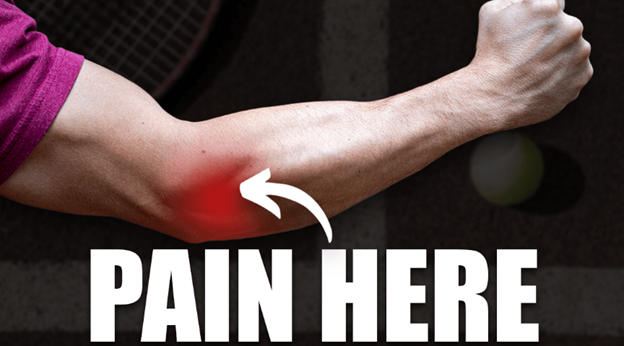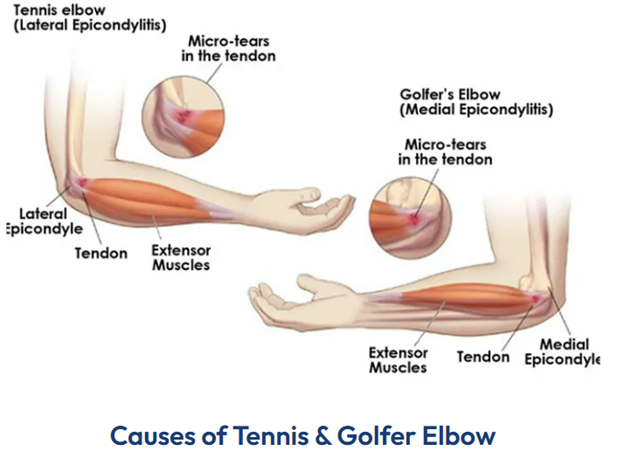What Is Tennis Elbow?
Tennis elbow, or lateral epicondylitis, is a chronic, painful condition caused by overuse and degeneration of the tendons that attach to the outer part of the elbow. Despite the name, you don’t have to play tennis to develop it any repetitive gripping or wrist extension can contribute.
Common symptoms include:
- Pain on the outer elbow
- Discomfort when gripping, lifting, or twisting (e.g., turning a doorknob)
- Tenderness at the tendon attachment
- Difficulty with daily tasks due to elbow discomfort
For many patients, the pain is persistent and frustrating, especially when physical therapy and injections don’t provide relief.



Traditional Treatment Options from Orthopedic and Sports Medicine Providers
Most patients are initially offered:
- Conservative Therapies
- Rest, activity modification
- Ice, anti-inflammatory medications
- Drawback: Often not sufficient once symptoms are chronic
- Physical Therapy
- Eccentric loading exercises, stretching, strengthening
- Drawback: May reduce pain but often doesn’t fully resolve it
- Injections
- Corticosteroids or platelet-rich plasma (PRP)
- Drawback: Temporary relief; steroids can weaken tendons over time
- Surgical Tendon Release
- Cutting or releasing part of the extensor tendon
- Requires anesthesia, incisions, and weeks of recovery
Drawback: Invasive, risk of complications, scar formation
At Vascular Clinic, we offer a minimally invasive alternative for patients who want relief without open surgery.
How We Treat Tennis Elbow at Vascular Clinic
Arterial Embolization for Lateral Epicondylitis
We now offer transarterial embolization (TAE) as an outpatient procedure to reduce elbow inflammation and pain without cutting the tendon.
How It Works:
- Under twilight sedation and local anesthesia, we insert a catheter through the radial artery in the wrist
- Using live X-ray, we navigate to the arteries supplying the outer elbow
- An arteriogram identifies abnormal neovessels—tiny, inflamed blood vessels contributing to pain
- Microparticles are injected to embolize only the abnormal vessels
- Healthy tissue and nerves are preserved, and elbow circulation remains intact

What to Expect After Embolization
- Procedure time: about 1 hour
- You go home the same day
- No incisions, no stitches, no immobilization
- Resume light activities within 1–2 days
- Pain relief develops gradually over the next 4–8 weeks, with continued improvement over months
You may continue physical therapy afterward to strengthen the tendon embolization creates a window of reduced pain to support healing.
Results and Safety
- Studies show significant improvement in pain and grip strength after embolization
- 80–85% of patients experience major relief and avoid surgery altogether
- The procedure is repeatable if needed (though most patients need only one treatment)
- Safety profile is excellent no damage to surrounding nerves or muscles when performed by skilled specialists
Frequently Asked Questions
Is this a new or experimental procedure?
No this technique is well established in Japan and Europe and is gaining recognition in the U.S. It’s considered part of the expanding field of musculoskeletal embolization.
How long does the pain relief last?
Many patients experience long-term improvement. If pain recurs years later, the procedure can be safely repeated.
Can I still have surgery later if needed?
Yes. Embolization does not limit future surgical options.
What does recovery look like?
No restrictions beyond avoiding strenuous elbow use for a few days. Most patients return to work and daily tasks almost immediately.
Why Choose Vascular Clinic?
- Experts in Musculoskeletal Embolization
- Minimally Invasive Approach with no surgical incisions
- Comfortable outpatient experience with rapid recovery
- Collaborative care with orthopedists and physical therapists
- Supportive follow-up with pain score tracking and ultrasound imaging if needed
At Vascular Clinic, we believe in relieving chronic pain with precision and compassion. If you’re tired of elbow pain limiting your life and you want to avoid surgery embolization may be the path forward.




